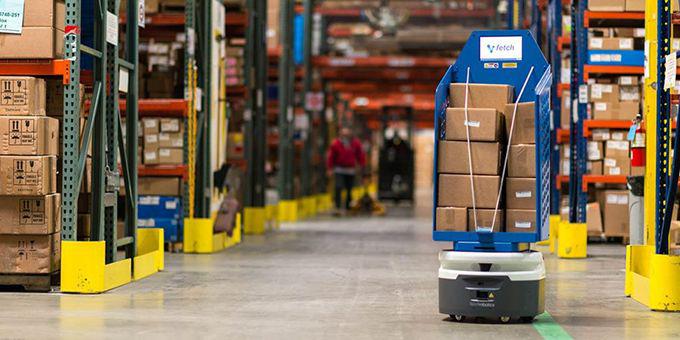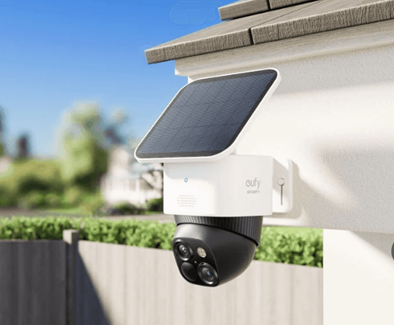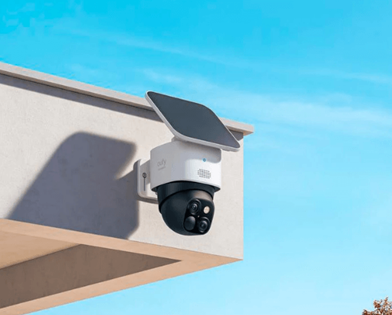Autonomous mobile robots are more than automated material handling
Zebra Technologies, a manufacturer of tools to digitize and automate workflows, had already augmented frontline workers in many industries with its barcode scanners and handheld mobile computers. Adding autonomous mobile robots (AMRs) to its offerings through the acquisition of Fetch Robotics looked like a good next step.
When the acquisition closed in 2021, Zebra, Lincolnshire, Ill., got a two-fer, including both brawn and brains.
At one end of the spectrum, it now offers technology that can accomplish weighty, brute-force tasks like lifting, carrying and pulling heavy stuff. After programming, Fetch and other AMRs used in manufacturing can act on their own to unload trucks at a dock, take materials to storage and put them on a shelf, carry components to a manufacturing line, become a virtual part of that same line, and even take out the trash.
AMRs’ autonomy calls up comparisons to self-driving cars, but these robots already have safety standards in place to ensure they can operate safely around humans.
At the other end of the spectrum, AMRs can have sophisticated software “brains” capable of applying artificial intelligence to logistics management. Their applications can analyze the jobs that need to be done and pair the individual tasks with the assets available to do the work.
“That’s exactly our whole focus, orchestration,” said Daniel Theobald, founder and CIO of Vecna Robotics, Waltham, Mass. “It’s like being a grandmaster in chess.”
How do you get the best throughput in your facility regardless of the fact it’s dynamic and unpredictable? Trucks come late, people don’t show up for work and pieces of equipment break down. Theobald said use of Vecna’s Pivotal orchestration software alone doubled the throughput in a shipping facility without any additional resources when it was used to help figure out the best assignments in real time.
“That probably sounds unbelievable but the reason it works so well is because the throughput of a facility is ultimately limited at any one time because of a single bottleneck,” said Theobald. “And human beings are not good at figuring out [in real-time] where that bottleneck is. That’s what AI is good at, looking at the system as a whole, taking into account thousands of variables.”
Why is all of that important? Simply put, AMRs enable machines and humans to do what they do best.
Machines are good at supplying the brawn needed to get jobs done. That’s not the case with humans, whose bodies suffer when they try to do physical tasks beyond their capabilities. With machines, engineering can be applied to accommodate heavier loads. When their batteries die down, they can be recharged. If something breaks, the part can be fixed or a new one installed.
Augmented Intelligence for Planning
Humans, unfortunately, are also not good at taking into account all the factors that affect performance in a factory, but that’s what software with AI running on the company’s server or in the cloud is really good at.
Fetch Robotics’ cloud-based robotic software, FetchCore, has the ability to not just optimize the robots or optimize the human workers but can optimize them collectively in a highly productive and efficient way, said Jim Lawton, vice president and general manager of robotics automation at Zebra Technologies/Fetch Robotics.
“What we’re able to do at Zebra is optimize both AMRs and people,” Lawton said. “So if I need a specific thing done, I can coordinate both of them so the person and the robot show up at the same time, at the same place, and do what they need to do. Then the person is guided to what their next task is, and the robot is guided to its next task and you’re constantly running in a much more optimized way.”
That efficiency and optimization is critical in manufacturing, where chronic labor shortages existed even before the Great Resignation that started in 2021 during the pandemic. Efficient operations can also free up time for the upskilling that’s needed to keep workers engaged and relevant in a world where automation is left to literally do the heavy lifting.
Can AMRs Become Part of Assembly Line?
Flex Ltd., a $24 billion global contract manufacturer based in San Jose, Calif., started using AMRs about 10 years ago and now has more than 300 of the autonomous material handlers in its more than 100 locations. Their robots are used in operations, factory, warehouse, logistics, service depot, repair and material holding settings.
“The main element of AMRs is it helps us with safety and ergonomics and also supporting our operations in Industry 4.0, where things are connected,” said Murad Kurwa, vice president of advanced manufacturing engineering.
Through the use of AMRs, Flex has realized about 20,000 worker hours of productivity gains as a result, according to figures provided by the company.
“Automated mobile robots are more than a necessity for Flex,” Kurwa said. “We use AMRs in many areas to support movement of raw material, work-in process inventory, bring finished goods to the loading station for shipping and various other duties that frees up our human capacity to focus on more skilled tasks in the transformation of products and to meet our customers’ expectations.”
Flex sees a wider-ranging role for its AMRs in the future, though, both literally and figuratively.
The company has started looking at 5G connectivity for AMRs, and has done some proof-of-concept work and pilots.
“5G as a replacement of the current Wi-Fi/LTE provides a broader signal spectrum with a private network, allowing receivers like AMRs to work continuously at a longer distance without signal decay or latency, which can cause AMRs to stall,” Kurwa said.

One possibility for AMRs at Flex is to become a virtual part of an assembly line, making the production floor more flexible and able to convert to different projects. The company is also exploring using AMRs to connect conveyance between steps in a moving line where there is a monument (e.g., furnace) that can’t be moved.
“Instead of having a linear flow, the AMR can come pick up the part and go around that monument and connect to the next step by using the conveyance on top of the AMR,” Kurwa said.
The biggest mistake would be to not fully exploit the capabilities of AMRs, said Theobald.
“Part of the magic here is what are those first tasks that are best addressed by this technology because we’re still early on in that adoption curve,” he said. “You know picking the right first tasks can make a huge difference.”
For example, consider the factory owner who replaces forklifts that used to be driven by human workers with driverless forklifts and goes on with business as usual. They ignore the fact that the driverless equipment has a whole set of attributes—it doesn’t take breaks, it doesn’t get tired, it can run for entire shifts, its schedule is coordinated and planned with AI—that are different from and exceed the limits of human workers.
“Generally that’s not the right approach,” Theobald said. “Oftentimes it pays to rethink your workflows.”
Variability Gives AMRs Chance to Shine
Once the human workers have an AMR, they want it to be easy to deploy.
“People understand their processes really well,” said Lawton. “They don’t necessarily need to understand robotics. So we’ve developed technology for people to very simply define their space, their workflow.”
Historically it’s taken 300 hours to program a robot, but Fetch Robotics’ AMR can be up and running in a day, he said. Programming the AMR generally means driving it around a factory. With Fetch Robotics, users use a drag-and-drop method to set up the FetchCore software.
“You need to be able to get something up and running in a facility really quickly and it needs to be able to accommodate the normal variabilities you see in a typical environment,” he said. “It’s where an AMR really shines.”
Eventually, a factory may have a heterogeneous fleet of AMRs, all with their own fleet management software. What to do then to get them working together?
If some of your robots are from Vecna, you’re all set. That’s because its Pivotal software is agnostic to the type of resource in a task management scenario. “Could be a human, could be our robot, could be a robot from another vendor, could be a piece of manually operated equipment,” said Theobald. “It has the ability to assign tasks to any of those based on their capabilities, location, and availability.”
In the meantime, MassRobotics, Boston, a nonprofit innovation hub for robotics and connected devices that Theobald co-founded, has issued an interoperability standard, MR Interop, for robot-to-fleet management reporting. It’s also in the process of creating the next version of the standard to allow task assignments to robots. MassRobotics is working on an interoperability standard for chargers too.
“We do hope that in the future fleet management software from any company can just use MR Interop and not need to integrate directly with those other robots,” he said. “MR Interop is a standard that makes that process easier.”
The interopability standard is already having an effect. Companies like FedEx have said they’re not going to buy robots that don’t conform to the MassRobotics interoperability standard, said Theobald. FetchCore has the capability to fleet manage a heterogeneous group of AMRs from different vendors, but hasn’t done so yet, Lawton said.
As for Flex, even though it uses hundreds of robots from three vendors, none of them co-mingle in the same facility, Kurwa said.
Having AMRs that plug and play together helps not only the user. It also has an effect on the growth of the industry itself. “Industries don’t scale until this interoperability stuff gets figured out, so we decided to take a page out of the computer industry or the cell phone industry,” Theobald said. “You could talk about the videotape industry, the whole VHS vs. beta thing. These tend to be very messy processes that sometimes take decades and really slow down customer adoption of these types of tools.”
Growth of AMRs Spawns Accessories, Third-Party Software
As the use of autonomous mobile robots grows, so does the need for software to control fleets of AMRs from disparate vendors and top-of-cart accessories to use with them.
One AMR manufacturer, Mobile Industrial Robots (MiR), Odense, Denmark, purposely created an open-platform robot.
“Think of us as just the base robot with a 48-volt lithium-ion battery, and we allow people to build whatever they want to on top of the robot,” said Matt Charles, sales director, Midwest and Canada. “You can put a robotic arm on top and that would be powered off our battery and communicate back and forth to our robot, when to move, when to go.”
While a robotic arm is possible, the top three top-of-cart modules for MiR’s AMRs are a conveyor deck, a pinning system to attach carts and a pallet lift, Charles said.
ROEQ (pronounced RO-eek, and whose name is a shortened version of “robotic equipment”), Vissenbjerg, Denmark, is MiR’s leading supplier of top-of-cart accessories. In fact, the company was created specifically to build top-of-cart modules for MiR AMRs, including carts, top rollers, lifters and racks. ROEQ co-founders Michael E. Hansen and Benni S. Lund were called to MiR in their previous capacity as consulting engineers, and saw an opportunity that led them to create a company.
“That’s where they discovered a gap in the market in the sense that they have a great technology, a great platform to move things but the entire ecosystem needed to be complete with the right tools to be able to pick up, drop off and transfer materials,” said Shermine Gotfredson, global sales director at ROEQ. “And that was the missing link.”
Their first product was the TMC 300, a top-of-cart rack, which is still in production. The latest new offerings from ROEQ are the TMS-C500 Ext and S-Cart500Ext, which are designed to work together. The new module/cart combination effectively doubles the payload of MiR’s 250 AMR from 250 kg to 500 kg. The TMS-C500 Ext top module also enables transportation of loads up to 1.2 m in length without compromising safety.
While ROEQ has so far aligned its business with MiR robots, factory owners may not be so loyal. Even as manufacturers provide software to manage their AMRs, achieving interoperability with a fleet of heterogeneous robots is more complicated. “That’s a common challenge that manufacturers have, and there’s a lot of push for interoperability and interfleets that can mingle and work together,” Charles said. “That’s something we’re working toward and there are other companies that are developing solutions as well.”
One of those companies is AWS (Amazon Web Services Inc.)
While it may be possible to modify one AMR’s controller software to act as a fleet manager for robots from disparate vendors, AWS has created AWS IoT RoboRunner to provide the infrastructure for integrating mobile robots from select vendors with work management systems and building robotics fleet management applications. Earlier this year, RoboRunner was in preview in a lab setting, and was expected to roll out soon after to production settings.
In addition to providing the infrastructure for building fleet management applications, AWS IoT RoboRunner provides two software libraries—a task manager library and a fleet gateway library —along with sample applications, making it easier for developers to build their robotics management applications on top of AWS IoT RoboRunner.
In addition, AWS IoT RoboRunner eliminates the need for numerous integrations among different robot control systems and a factory’s work management system. Instead, all systems integrate with AWS IoT RoboRunner, and the service connects all integrated systems automatically.
Also, AWS IoT RoboRunner makes it easier for developers to build management applications with the task manager development library. This library also comes with a sample task orchestration application that includes a shared space management feature. Developers can use this sample application as a starting point to accelerate their application development.
“More and more customers in manufacturing, logistics, and consumer goods are using robotics and autonomous systems in their operations but struggle to manage those systems for orchestrating complex robotics tasks like object picking and inspection in warehouses across fleets or robots,” said Eric Anderson, general manager, robotics and autonomous systems, AWS. “With AWS IoT RoboRunner, we’re making it easier for customers to incorporate, manage and orchestrate robotics in their operations and make their autonomous systems smarter, based on the same technology used across Amazon logistics and fulfillment centers.”









